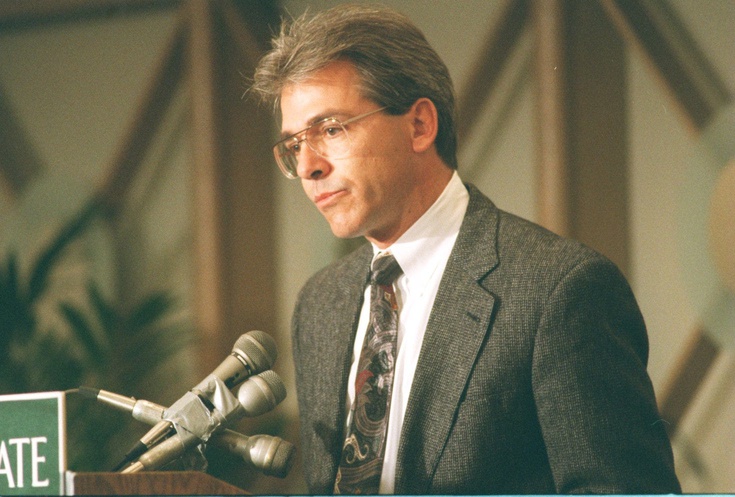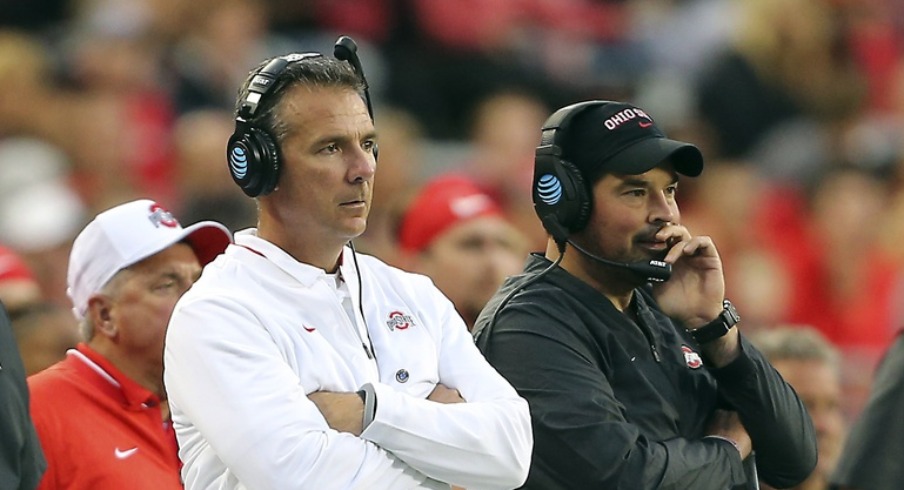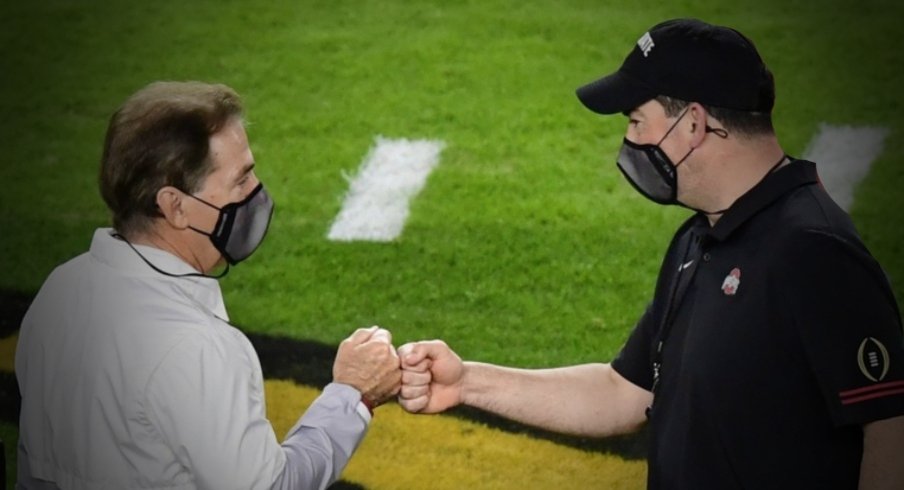Michigan State went 9-2 during the 1999 regular season.
This was only Sparty's second nine-win season since 1966, so it was a pretty big deal. The bigger deal was MSU's triumphant emergence from the anchor of a four-year NCAA probation that had been George Perles' parting gift to the program.
The Spartans had nine wins, all of their suspended scholarships returning, no NCAA gray cloud overhead and were officially contenders again. Alas, the celebration was muted for worthy reasons.
Those two losses were of the ugly variety; by 24 and 30 points to Purdue and Wisconsin respectively. They had gotten housed in consecutive weeks and legitimate contenders don't get their clocks cleaned multiple times in conference play. This was also the first nine-win season in program history that hadn't accompanied a conference title.
Saban was 48 when he left MSU for LSU, and his membership in the Youthful Up-and-Comer coaching category was expiring.
And head coach Nick Saban promptly skipped town after that ninth win was secured, completing a five-year stint in East Lansing where he had only delivered .500ish results up until that breakthrough 1999 season. He didn't stick around for the bowl game.
It was his breakthrough season too. Bigger things awaited beyond Ann Arbor's oppressive in-state shadow.
Saban was 48 years old when he left Michigan State for what was then blue blood-adjacent LSU, and his membership in the Youthful Up-and-Comer coaching category was expiring. Coaching was aging him at an accelerated pace, he had yet to win a single bowl game and his only conference title came at Toledo, where he coached for one season.
He lost 16 times in five seasons leading the Spartans, which is one more loss than he's suffered at Alabama over the past 15 years. Saban is no longer youthful or an up-and-comer, and no one saw any campus statues in his future when he correctly decided Baton Rouge had a longer runway than East Lansing.

Bobby Bowden owns the only comparable career path. The rest of the college football coaching legends were deemed prodigies from the jump like Bear Bryant or Joe Paterno, smaller-program overlords or simply coached long enough at a passable level to accumulate a sizable win total. Woody was already retired for five seasons at this point in Saban's career. This is as close to uncharted as it gets.
Which is to say he was never the hot young coach Urban Meyer was. Urban led Utah to an undefeated season and a BCS victory at the same age Saban was at Toledo. When he was Lincoln Riley's current age, he was coaching Houston Oilers defensive backs.
The consequences of building a legend vs. being born one is Saban will never own career marks like Most Wins or Winning Percentage. It was all worth the wait. If you look at the Youthful Up-and-Comer catalog from college football's past 20 years you'll find a whole bunch of discontinued legends-in-waiting.
- Will Muschamp, whom Texas once retained for years as a coach-in-waiting after Mack Brown.
- Derek Dooley, who was hired by Saban more than once and is now a journeyman assistant.
- Lane Kiffin, whose coaching reputation is clawing back after rehabilitating under Saban.
- Mike Leach, who has devolved from offensive genius into reliable soundbite.
- Skip Holtz, who is now 56 and coaching Louisiana Tech.
Other former high-ceiling whippersnappers include Kirk Ferentz, Mark Dantonio and Pat Fitzgerald, all of whom made themselves comfortable running successful B1G non-dynasties while declining to dye away their gray hairs. They keep getting older but Saban stays the same age. They all had head starts but they'll never catch him.
Alabama has tried to hire coaching prodigies fairly recently. Dennis Franchione has already retired. Mike DuBose coaches high school ball. Mike Shula is now a career NFL QB coach. They failed at Alabama in spectacular fashion. The job was probably too big and too soon for them. We'll get back to that point in a moment.
Many young coaches are content lording over respectable fiefdoms. Saban wanted to rule all of it.
He's been 55 for the past 15 seasons, leading a run unlike any other in college football history. If you're looking for the next Nick Saban, you can disqualify anyone under the age of 50 from consideration. That's not where you'll find him, if he exists.
There's plenty of exciting youth in the B1G, and none of it shaking up the natural order. Scott Frost will have Nebraska one year away as long as he's there. P.J. Fleck is Rowing the Boat™ in Minneapolis, until he rows it elsewhere. Every other B1G coach is either north of 50 or turning 50 except for one - and those are the candidates to bloom like Alabama's head coach did.

But it's that one - the guy Urban Meyer declared elite and handed Ohio State's keys to when he decided to retire from his dream job - that we're looking at as having the best shot of being the next college football emperor. Saban was 28 and running the Buckeyes' DB room for Earle Bruce when Ryan Day was celebrating his first birthday.
Right now, that's the only thing the careers of Saban and Day have in common - they were both assistants at Ohio State. Alabama's head coach already has a statue on campus and will likely end his coaching career sometime in the next decade without suffering a decline. He's just getting more dominant as he turns 70 this year.
While Day is 23-2 through 25 games, Saban was 16-8-1. He's arguably the best coach in college football history - but objectively not among Michigan State's top five. Accomplishing what Saban has done since the first time he turned 55 over an entire career is as impossible as it is unsustainable.
The good news for Ohio State fans is that it does not appear that the job is too big for Day, which is a dynamic that has consumed nearly every coach between Bryant and Saban.
whenever a Power 5 HEAD coach loses his job, it's a strong bet he'LL end up on ALABAMA'S staff as part of SABAN'S proven image rehabilitation PROGRAM.
Prodigies come and go, and the Buckeyes currently employ one who inherited a machine few ever get to drive or build. Saban is in a rarified position in his career and time where whenever a Power 5 coach loses his job, it's a strong bet he's going to end up on Alabama's staff as part of Saban's proven image rehabilitation program.
Saban gets aces to fill his apprenticeship vacancies. It's a position of strength that only fortifies the competitive advantage he has built. Meanwhile, Day has been leveraging the entire Ohio State athletic department to retain Al Washington from taking a promotion elsewhere. The tradition, facilities and recruiting all stack up.
But Alabama at the current moment has moved beyond all of that. It's a perk of having the best ever at the helm. It's hard to imagine Ohio State as a scrappy up-and-comer in any other context.
They may be coaching two of the top five programs in the sport, but Saban and Day are barely peers in what or how they are able to operate. That's in part because Saban is without peer in today's college football landscape, or possibly any other.
Which presents Day with the bar his program needs to clear: Not Clemson, whose One Sneaky Trick was solved for and hacked in New Orleans, and it's not That Team Up North, though there will never be a reason to tap the brakes on dominating that relationship.
It's the best coach in the game, leading the sport's top program. The tallest possible task, for a coach whose career is way ahead of schedule.



